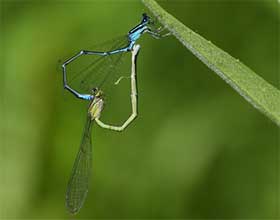 What are these animals?
What are these animals?
This is a pair of stream bluet damselflies, Enallagma exsulans, a common species found in every Ohio county. Damselflies, along with dragonflies, make up the insect order Odonata (so, to enthusiasts, they are called odonates, or sometimes just “odes”). Damselflies are typically smaller than dragonflies, with skinnier abdomens. Their prominent eyes, which sport cool colors and patterns in many species, are set on either side of their head. (In dragonflies, the eyes meet at the midline). And damselflies usually hold their wings vertically above their body, rather than out to the side as in dragonflies.
Why are they called stream bluets?
All adult odonates eat insects, which they catch on the wing, and so it’s easy to think of them as animals of the land and air. However, odonates lay their eggs in water, where the juveniles, called nymphs or naiads, are predators on pretty much anything that moves. In fact, the aquatic stage of life commonly lasts longer than the adult stage. Stream bluets prefer to lay their eggs in moving water rather than lakes or ponds, and so streamside habitat is a good place to find them. As for the name “bluet,” that’s simple: most of the “bluet” damselflies are, at least in part, blue. About ten species of bluets inhabit Greene and Montgomery Counties. Each species has a unique pattern of male coloration, though seeing those differences sometimes takes careful inspection. In fact, the genus name Enallagma derives from the Greek word for “confusing,” reflecting the many similar species of bluets.
Why are the two individuals different colors?
Odonates are visual animals, and their colors and patterns serve a variety of signaling functions. As part of that, many odonates exhibit sexual dimorphism, meaning that males and females look different. As in birds, the male is usually more colorful; the bright blue individual in this picture is the male. That male coloration contributes to species identification as males and females seek mates or as males compete with each other for access to females. Also similar to the situation in birds, blue coloration in damselflies does not result from blue pigments. Rather, the blue coloration is “structural”, meaning that it results from patterns of light reflection within the structure of the exoskeleton. However, insect exoskeletons are made of chitin, whereas bird feathers are keratin, and so the specific structures underlying color production are not identical.
Why are the animals forming a heart?
These animals are mating, meaning that the male is delivering sperm to the female. Male odonates produce sperm in the terminal segment of their abdomen (segment 10). However, from there they transfer the sperm in a packet to a more forward-positioned chamber, the sperm accessory organ, or receptacle, located near the thorax on abdominal segments 2 and 3. During mating, the male uses his cerci (specialized claspers at the tip of his abdomen) to grab onto the female near the front of her thorax. Each damselfly species has a specific shape of the male cerci and female thoracic groove, which helps to assure that only males and females of the same species join for mating. The female then places the tip of her abdomen by the male’s sperm receptacle and receives the packet of sperm. Mission accomplished! The combination of male and female positioning for that transfer results in what usually is called the “wheel position.” But it rarely actually forms a shape resembling a wheel, and sometimes, as in this photo, the animals curve their abdomens in a way that makes a perfect heart.
What happens next?
Damselflies can remain in the mating wheel formation for many minutes. Once sperm transfer is complete, the female goes on to lay her fertilized eggs. The male often remains attached to his mate’s thorax while she lays eggs, guarding his investment against intrusion by other males. Stream bluets deposit their eggs on streamside vegetation, either slightly above or below the water line. The adults probably die within the following few weeks. However, the nymphs overwinter under water and do not emerge and metamorphose into the next generation of adults until the following year.
Article and photo contributed by Dr. David L. Goldstein, Emeritus Professor, Department of Biological Sciences, Wright State University.
